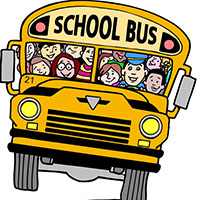— by Lin McNulty —
School starts tomorrow and Orcas Island students, along with some 25 million students nationwide, begin and end their day with a trip on a school bus. Designed for safety, with flashing lights, giant mirrors, high seat backs and that bright yellow color, school buses keep more than 17 million cars away from school buildings every day.
While riding a bus to school is safer than riding in the family vehicle or walking, the National Safety Council (NSC) supports the incorporation of lap and shoulder belts in school buses – and across multiple modes of transportation – to ensure the safest ride for children.
Seat Belts Save Lives and Reduce Injuries
Since 2002, passenger lap and shoulder belts have been made available on school buses; California, Florida, Louisiana, New Jersey, New York and Texas require them.
The National Highway Traffic Safety Administration (NHTSA) stated its support for lap and shoulder belts on buses in 2015, and NSC has joined in support of this position. NSC also recommends states or school districts consider this added safety benefit when purchasing buses.
In 2012, a side impact crash involving a school bus and a commercial vehicle in Chesterfield, NJ, resulted in the death of one student and serious injuries to others. Lap belts were available, but some students did not use them. The difference in safety is clear, as seen in this simulation.
NSC also is calling for children age two and younger to be properly restrained in their own seat on airplanes, and encourages ambulances, police vehicles, and recreational vehicles to accommodate the unique needs of child passengers.
Tips for a Safe Ride
School buses are the safest way for students to travel, but children also need to do their part to stay alert and aware of their surroundings to prevent injury. NSC urges parents to teach their children the following safety rules for getting on and off the bus, and for exercising good behavior while riding.
Getting on the Bus
- When waiting for the bus, stay away from traffic and avoid roughhousing or other behavior that can lead to carelessness
- Do not stray onto the street, alleys or private property
- Line up away from the street or road as the bus approaches
- Wait until the bus has stopped and the door opens before approaching the bus
- Use the handrail when boarding
Behavior on the Bus
- If seat belts are available on the bus, buckle up
- Don’t speak loudly or make loud noises that could distract the driver
- Stay in your seat
- Don’t put your head, arms or hands out the window
- Keep aisles clear of books and bags
- Get your belongings together before reaching your stop
- Wait for the bus to stop completely before getting up from your seat
Getting Off the Bus
- Use the handrail when exiting
- If you have to cross in front of the bus, first walk at least 10 feet ahead until you can see the driver
- Make sure the driver can see you
- Wait for a signal from the driver before crossing
- When the driver signals, look left, right, then left again. Walk across the road and keep an eye out for sudden traffic changes
- If your vision is blocked, move to an area where you can see other drivers and they can see you
- Do not cross the center line of the road until the driver signals it is safe
- Stay away from the rear wheels of the bus at all times
More school-age pedestrians have been killed during the hour before and after school than any other time of day, according to NHTSA. And, although drivers are required by law to stop for a school bus when it’s loading or unloading passengers, they often don’t. Children should not rely on them to do so.
TOMORROW: Safety Tips for Car Drivers
**If you are reading theOrcasonian for free, thank your fellow islanders. If you would like to support theOrcasonian CLICK HERE to set your modestly-priced, voluntary subscription. Otherwise, no worries; we’re happy to share with you.**








